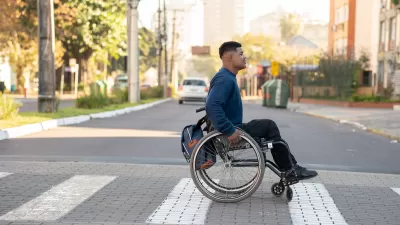“Getting” Universal Design creates an “Aha!” moment. Experiencing Universal Design creates a “Wow!” moment.
"Getting" Universal Design creates an "Aha!" moment. Experiencing Universal Design creates a "Wow!" moment.
Universal Design is the misunderstood love child of the accessibility movement pioneers and the Americans with Disabilities Act (ADA). The early advocates learned that good design for people with a wide range of disabilities translates into good design for everyone. The ADA created a base line of requirements that addresses a narrow range of mobility disabilities. Born of enlightened advocacy for the diversity of human experience and well-meaning, consciousness-raising legislation, Universal Design suffers from an image problem that equates it with "uber-accessibility."
Universal Design isn't "uber" anything. It is a call – a cry, really – to put people, who experience life in myriad ways, at the center of design. That's IT. Period.
It seems to be gaining currency. In design, the industrial and product designers have "gotten" it for years. The architects, planners and landscape architects are just catching on. I fear that the well-meaning, earnest ADA may have had some hand in this, but the love child is ready to lead them on their way to beauty and happiness.
A very simple idea. Peter Merholz, a designer who works with Adaptive Path has written a wonderful article that can be found at http://www.core77.com/reactor/06.07_merholz.asp. The essence of his message is that the most successful designs – those that have enjoyed the "Wow!" moments - come from designers (Eastman with Kodak, Jobs with Apple) who design for the human experience. Out of that philosophy came products, but the purpose is to enhance the human experience. Wow.
The alternative, designing to parameters and features, he argues, results in convoluted solutions. Do you use all that functionality in your cell phone? How about that printer/fax/scanner/copier? Is it intuitive, functional and beautiful? Why not? According to Merholz, designers stop too soon. They stop when the basic problem is solved; but the elegance comes with time and when the designer thinks about the experience that people will have. In the words of artist Timothy Berry, "I would have made simpler drawings, but I didn't have the time."
John Maeda, designer, artist, computer scientist, MIT professor, and founder of the Simplicity Consortium at the MIT Media Lab, agrees. Although his titles defy his own cause, his most recent book, The Laws of Simplicity, is a delicate and delightful musing and measure of simplicity. He embarked on a journey to unravel the laws/complexity of simplicity as an antidote to the sense that we are all feeling overwhelmed – most often as a result of technology. Citing Apple and Google as powerful examples, he observes "People not only buy, but more importantly love, designs that make their life simpler." Bingo! We come full circle.
From zoning laws to apple peelers, people are the users, people are the beneficiaries, people thrive or wither with the experience of everyday design, and of design every day.

Maui's Vacation Rental Debate Turns Ugly
Verbal attacks, misinformation campaigns and fistfights plague a high-stakes debate to convert thousands of vacation rentals into long-term housing.

Planetizen Federal Action Tracker
A weekly monitor of how Trump’s orders and actions are impacting planners and planning in America.

In Urban Planning, AI Prompting Could be the New Design Thinking
Creativity has long been key to great urban design. What if we see AI as our new creative partner?

How Trump's HUD Budget Proposal Would Harm Homelessness Response
Experts say the change to the HUD budget would make it more difficult to identify people who are homeless and connect them with services, and to prevent homelessness.

The Vast Potential of the Right-of-Way
One writer argues that the space between two building faces is the most important element of the built environment.

Florida Seniors Face Rising Homelessness Risk
High housing costs are pushing more seniors, many of them on a fixed income, into homelessness.
Urban Design for Planners 1: Software Tools
This six-course series explores essential urban design concepts using open source software and equips planners with the tools they need to participate fully in the urban design process.
Planning for Universal Design
Learn the tools for implementing Universal Design in planning regulations.
Gallatin County Department of Planning & Community Development
Heyer Gruel & Associates PA
JM Goldson LLC
City of Camden Redevelopment Agency
City of Astoria
Transportation Research & Education Center (TREC) at Portland State University
Jefferson Parish Government
Camden Redevelopment Agency
City of Claremont






























